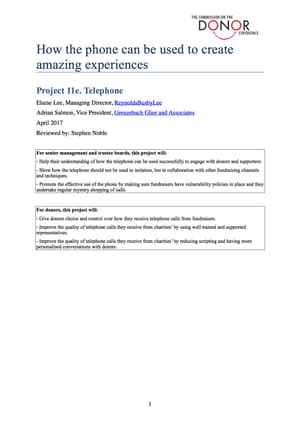CDE project 11e telephone: case study — Erskine Stewart’s Melville Schools, Edinburgh
- Written by
- The Commission on the Donor Experience
- Added
- April 20, 2017
The problem we wanted to solve, an idea we wanted to test
We wanted to have more regular to and fro contact with some of our community, not just us sending information out but actively seeking feedback from the community. For us, community consists of alumni, parents & extended family and other friends of the school. These were affinity calls, not fundraising and the charitable aspect of our work and funds were not mentioned other than in an administrative fashion.
How we implemented it
Rather than have a dedicated campaign, we decided to integrate this into our daily work, initially for a term but it’s been extended for another six months. We started by contacting those who contacted our office for various reasons, booking into events, enquiring about programmes etc.
For each email or letter received, we called to have a chat to learn more about what had attracted them to the event or programme and what else they may be interested in. Sometimes we were seeking permission to add contact details to the database, e.g. email addresses or name changes. Sometimes we congratulated people on life milestones such as having a baby or getting married or changing jobs. Often these conversations led on naturally to other areas of the school and how the parents or alumni could see or had experienced issues.
This has enabled us to improve all sorts of things around the school from their feedback including launching a dedicated section of the parent portal to display sports team results and a new news feed on the main school website for alumni. It’s also given us greater understanding of what is valued about our programmes so that we can focus more on these aspects and drop those which are seemingly effective but from which our constituents derive little value.
What happened, and how we measured it
We measured how many of each constituent group were contacted and which topics were covered using a straightforward tick box system on the database. We kept more detailed notes of many conversations in another section but it was not possible to query on such levels of detail, hence the tick box system. We also assigned a ‘score’ to each conversation to try to reflect how engaged the contact had been and how warm. This was on a scale of 1 to 10 with higher scores meaning warmer and friendlier. This was not done scientifically by listening for particular words but was done on how positive the person had sounded and how constructive their suggestions for improvement were and how likely we felt they would react positively to future calls along the same lines.
Any obstacles that got in the way and how we addressed them
It would have been lovely to include an ‘ask’ on calls where it was appropriate but our governing council do not allow fundraising by telephone so this was not possible. It will be interesting to see when our mailed appeal goes out in April if those contacted do give and if they give more or more frequently. We did notice an increase in ad-hoc donations over this period but there has not yet been time to go back and analyse this data compared to those contacted.
Time is another factor as we didn’t increase staffing in any way for this project and the calls had to be squeezed in around other jobs. It’s surprising how much you can get done whilst on the phone though! We often have a lot of event preparations to do so it’s easy to fold tombola tickets whilst on the phone.
What implications we think this has for our future engagement with donors and supporters over the phone
It is certainly something that I will continue to do and develop over the years as it’s been fantastic for us in so many ways, from identifying prospects for major gifts to developing deeper relationships with key members of our community. It’s become part of our daily work and we quite look forward to our chats with parents and alumni.



















